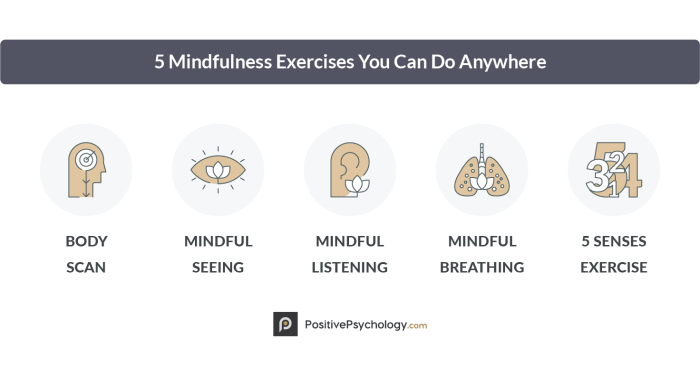Mindfulness Exercises takes center stage, inviting you into a world where mental health benefits and stress reduction are key players. Dive into the realm of focus, concentration, and overall well-being with engaging practices that can transform your daily routine.
Benefits of Mindfulness Exercises

Practicing mindfulness exercises can have a positive impact on mental health by promoting overall well-being and reducing stress levels. These exercises encourage individuals to focus on the present moment, enhancing self-awareness and emotional regulation.
Improved Focus and Concentration
- Mindfulness exercises, such as meditation and deep breathing, help train the mind to stay present and focused on the task at hand.
- Regular practice of mindfulness can increase attention span and enhance cognitive abilities, leading to improved focus and concentration.
- By learning to observe thoughts without judgment, individuals can better control distractions and maintain concentration throughout daily activities.
Reduced Stress and Anxiety Levels
- Engaging in mindfulness exercises can reduce the production of stress hormones in the body, leading to a decrease in overall stress levels.
- Practicing mindfulness promotes relaxation and helps individuals manage anxiety by calming the mind and body.
- By focusing on the present moment and accepting thoughts and feelings without judgment, mindfulness exercises can alleviate symptoms of anxiety and promote a sense of calm.
Types of Mindfulness Exercises
Mindfulness exercises come in various forms, each offering unique benefits for overall well-being. Here, we will explore different types of mindfulness exercises, including breathing techniques, body scans, and mindful walking.
Breathing Techniques
Breathing techniques are a fundamental aspect of mindfulness practice. One common exercise is deep breathing, where you focus on the sensation of air entering and leaving your body. Another technique is box breathing, involving inhaling, holding, exhaling, and holding again in equal counts. Practicing breathing techniques can help reduce stress, increase focus, and promote relaxation.
Body Scans
Body scans involve bringing awareness to different parts of your body, noticing any tension or sensations without judgment. This practice helps you connect with your body and release physical and emotional stress. To practice a body scan, start from your toes and slowly move your attention upwards, scanning each body part along the way.
Mindful Walking
Mindful walking combines movement with mindfulness, allowing you to focus on each step and the sensations in your body as you walk. This exercise can be practiced indoors or outdoors, and it helps bring your attention to the present moment while promoting relaxation and reducing anxiety. To practice mindful walking, pay attention to each step, the feeling of your feet touching the ground, and the rhythm of your breath.Each type of mindfulness exercise offers unique benefits for overall well-being, such as reducing stress, improving focus, enhancing self-awareness, and promoting emotional regulation.
By incorporating a variety of mindfulness exercises into your daily routine, you can cultivate a greater sense of mindfulness and well-being in your life.
Incorporating Mindfulness Exercises into Daily Routine
In today’s fast-paced world, finding time for mindfulness exercises can seem challenging. However, with a few simple strategies, you can easily incorporate these practices into your daily routine.
Strategies for Integrating Mindfulness Exercises into a Busy Schedule
- Start small: Begin with just a few minutes of mindfulness exercises each day and gradually increase the duration as you become more comfortable.
- Schedule it in: Block off specific times in your day dedicated to practicing mindfulness, whether it’s in the morning, during lunch, or before bed.
- Combine it with other activities: Practice mindfulness while doing everyday tasks like washing dishes, walking, or even during your commute.
Creating a Conducive Environment for Practicing Mindfulness Exercises
- Find a quiet space: Choose a peaceful area at home or work where you can relax and focus without distractions.
- Add calming elements: Incorporate soothing scents, soft lighting, or gentle music to create a tranquil atmosphere for your mindfulness practice.
- Use reminders: Set alarms, sticky notes, or cues in your environment to prompt you to take a break and engage in mindfulness exercises.
Importance of Consistency in Incorporating Mindfulness Exercises into Daily Life
- Builds a habit: Regular practice helps solidify mindfulness exercises as a routine part of your day, making it easier to maintain over time.
- Enhances effectiveness: Consistency allows you to experience the full benefits of mindfulness, such as reduced stress, improved focus, and enhanced well-being.
- Fosters self-discipline: By committing to daily mindfulness exercises, you cultivate discipline and mindfulness in other areas of your life as well.
Mindfulness Exercises for Specific Situations

Mindfulness exercises are not only beneficial for general well-being, but they can also be particularly helpful in specific situations where emotions run high, relationships need nurturing, or creative problem-solving is required.
Managing Emotions During Challenging Situations
When faced with challenging situations that trigger intense emotions, mindfulness exercises can help bring a sense of calm and clarity. One effective exercise is:
- Deep Breathing: Take slow, deep breaths to center yourself and focus on the present moment. Inhale deeply through your nose, hold for a few seconds, and exhale slowly through your mouth. Repeat several times until you feel more grounded.
Improving Relationships and Communication
Mindfulness exercises can enhance relationships by fostering better communication and understanding. Try the following exercise:
- Active Listening: Practice listening without judgment or interruption. Focus on the speaker’s words, tone, and body language. Reflect back what you’ve heard to ensure mutual understanding and connection.
Enhancing Creativity and Problem-Solving Skills, Mindfulness Exercises
Engaging in mindfulness exercises can boost creativity and improve problem-solving abilities by quieting the mind and encouraging fresh perspectives. Here’s a useful exercise:
- Mindful Walking: Take a leisurely walk in nature or a quiet space. Pay attention to each step, the sensations in your body, and the sounds around you. Allow your mind to wander freely and observe any creative ideas that may arise.
